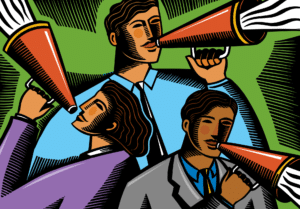Speak-Up and Call-Out Culture

Companies thrive when potentially useful information is freely available and employees feel that they are valued, consequential members of the organization. Speak-up culture is crucial on both counts: it means that management can receive important information from anyone who has it, and it means that employees’ autonomy is recognized and respected. However, the efficacy of speaking up depends on the actions taken in light of new information.
Speak-up mechanisms are also a critical part of any compliance program. Employees are often reluctant to report observed wrongdoing because of internal-power dynamics, and so it is important to provide an anonymous mechanism for them to raise concerns and an investigative process to follow up on allegations. There is still considerable evidence that whistleblowers are frequently penalized for their efforts, government awards for whistleblowing notwithstanding. If a company can build a credible, trusted speak-up mechanism, this will help enormously with efforts to implement an ethical culture. Of course, there’s always a risk that sharing information openly will reveal truths damaging to company personnel, or the entire organization. There is also the complementary risk that someone may put forward false information that spreads quickly, doing damage before anyone can correct it. When speaking up is prevalent, employees also become aware that they are susceptible to more scrutiny themselves.
In recent years, attention has also turned to questions of when and how speaking up may morph into calling out (i.e. public shaming for an alleged moral violation), which can undermine trust and increase fear. Social media—including internal channels such as Slack—has made it possible for anyone to call out anyone else, and awareness of this reality is on the rise. More broadly, companies and their executives are finding that legal-confidentiality provisions and public-relations efforts are less effective as a result of social media, meaning that their actions are increasingly held up for judgement in the public square.
These competing benefits and risks of speaking up lead to several questions: What mechanisms should exist that enable sharing concerns privately about potential wrongdoing? How can companies respond to new demands for transparency, without finding they have unwittingly created surveillance culture? How can information sharing be promoted without also inviting increased risk?
Ideas to Apply
- Think of speaking up as part of employees’ jobs, and the information they offer as part of what they contribute to the company.
- Make sure the consequences of giving and receiving feedback incentivize offering, soliciting, and incorporating it.
- Be transparent in responding to feedback to reinforce employees’ trust and their decision to speak up.
- Make use of employee feedback both in day-to-day work and to improve policies and processes.
- Create feedback systems to capture insights from feedback and dissent, and advertise providing and using it as the norm.
- Recognize how threatening negative feedback can be when it applies to a person rather than an attitude or practice, and provide employees with training, resources, and modeling for taking negative feedback as an opportunity for growth and learning, rather than as a threat.
- Focus on highlighting the need, request, and motivation for change, rather than delivering punishment (including when enacting concrete negative consequences).
Areas of Research
Speaking Up
Speaking up inside an organization can be viewed as a risky exercise of employee voice that, like other prosocial behaviors, is more likely to occur in conditions of safety and security (Jolly & Lee, 2020). Employees are more likely to speak up when their basic needs for relatedness and competence are met by their leaders’ inclusive behaviors (i.e. communication, openness, and accessibility) and when they have reason to expect doing so to be both productive and safe.
An anonymous third party may provide a safe platform for speaking up on more serious matters, such as violations of policies or laws, or personal misconduct. Such channels offer an opportunity for the company to remedy issues without their being escalated to media, lawyers, or the government. Employees may also believe their anonymity is better protected through these mechanisms.
The challenge of creating a thriving speak-up culture comes down to creating a climate where feedback is welcomed and effectively used, empowering employees to use their voice despite common fears, and funneling speaking up through appropriate channels (i.e., internal processes) rather than creating the opportunity for this information to be forced through more damaging external or public routes.
Psychological Safety
The strength of a speak-up culture depends in part on the presence of psychological safety (e.g. Kahn, 1990), meaning that employees’ willingness to speak up depends on whether they believe they will be vulnerable to negative consequences as a result of expressing their ideas or observations. Employees are more likely to speak up in the context of systems that make doing so neither “useless” nor “dangerous” (Morrison & Milliken, 2000, p. 721). As might be expected, psychological safety strongly predicts using prohibitive voice (employees’ expressions of concern about work practices, incidents, or employee behavior) to communicate concerns inside organizations (Liang et al., 2012).
When employees specifically feel it is part of their job to contribute by bringing about constructive change, known as “felt obligation for constructive change” (Fuller et al., 2006), they are particularly likely to use promotive voice (employees’ expression of new ideas or suggestions). The use of promotive voice, in turn, is associated with having higher organization-based self-esteem (believing oneself to be a more competent and valued member of the organization) (Pierce et al., 1989), which itself predicts voice in a virtuous circle.
Employees’ use of voice can come to be viewed as part of their job rather than as at odds with it, and managers can come to understand their job as eliciting and facilitating employee voice just as they do other employee contributions (Coqual, 2020). For example, a manager may remind her team that while she is accountable for the team’s overall performance and direction, they are all there because their perspective and opinions are considered valuable, and she expects them each to take responsibility for sharing ideas and information they are aware of that may impact the team’s work.
When speaking up runs through employees’ work rather than alongside as a “second job,” the time allotted to projects takes the time and energy required to speak up into account. Managers also reach out directly and regularly to solicit feedback, as would be expected if they find it valuable. Companies can also encourage speaking up by providing relevant resources to employees at every level. Employees can be trained explicitly on how to speak up, particularly in the moment before a situation has had the opportunity to increase in severity or complexity. To combat managers’ fear of negative feedback, companies can both train them in relevant competencies (e.g., active listening, replacing defense mechanisms with communication-supporting coping strategies) and demonstrate that listening to and acting on employee feedback boosts managers’ careers.
When perceived organizational politics give rise to a complicated social context, psychological uncertainty results and employees are less likely to speak up. Research by Li & Farh (2020) demonstrated that psychological uncertainty reduced employees’ likelihood of speaking up, beyond the effects of psychological safety, and that it reduced the likelihood of speaking up about both suggestions (promotive voice) and concerns (prohibitive voice) (Van Dyne et al., 2003). Li & Farh (2020) also found that having more autonomy in one’s job mitigated the negative influence of psychological uncertainty on promotive voice, whereas perceiving greater job security reduced the impact of psychological uncertainty on prohibitive voice.
How incidents are handled when they arise and are reported is also crucial to making employees feel it will be productive (and safe) to speak up. In order for employees to speak up, they must trust the recipients of the information they share, which requires responses to that information to be active and transparent (Coqual, 2020).
The theory of the spiral of silence (Noelle-Neumann, 1974; Moy & Scheufele, 2000) suggests that not speaking up makes others less likely to speak up by making the opinion climate appear less diverse than it is. Increasingly, one opinion can appear predominant as it becomes increasingly unusual and uncomfortable to express what appear to be minority opinions. Sharing a different perspective breaks the illusion of consensus, and makes it feel more normal for others to share their thoughts, even when they differ among themselves.
The benefits of promoting employee voice may be greatest in the areas that present the most complex challenges. This is because employees—especially younger employees—may be best equipped to deal with the systemic challenges that companies face today, ones that require an exploratory response since they currently lack solutions (Taylor, 2020). Rather than being threatening, the ideas and information that employees share can be viewed as contributions that support a company’s ability to adapt. The same is true for internal reporting, where higher rates of internal reporting are not correlated with more severe or frequent problems at a company, but rather indicate “open communication channels between employees and management and a belief that issues raised will be addressed,” and actually predict lower fines and fewer lawsuits (Stubben & Welch, 2018).
Organizational diversity may also be a factor in creating increased psychological safety (Newman et al., 2017). However, the benefits of diversity on its own are unclear in terms of speaking up and job performance (Eagly, 2016) and these may depend on additional factors such as organizational climate (Cropley & Cropley, 2017). Firms with so-called 2-D diversity, consisting of inherent (demographic) and acquired (gained from experience) diversity, both out-innovate and out-perform others, being 45 percent more likely to have grown their market share over the previous year and 70 percent more likely to have captured a new market, according to employee reports (Hewlett et al., 2013).
However, diversity can actually be a detriment without psychological safety. Newman (2017) reported that diversity of experience (acquired) was more positively associated with performance in the presence of high psychological safety, and negatively related to performance when psychological safety was low. In other words, psychological safety may be easier to achieve with diversity, but diversity alone is not sufficient. Promoting employee voice is particularly important when top management’s characteristics differ from their employees’; the value and relevance of differing perspectives must be made explicit (i.e., included in job description, responded to and made use of, looked to frequently for input) to overcome the automatic assumptions and fears arising from salient differences.
Individual Resistance to Speaking Up
Psychological safety is inhibited by the way humans have evolved to manage threats. Various psychological self-preservation processes may limit speaking up, due to fear of consequences in multiple forms. Milliken et al. (2003, p. 1453) concluded that the most frequently mentioned reason for not speaking up within one organization was “the fear of being viewed or labeled negatively, and as a consequence, damaging valued relationships.”
Employees may fear, even without justification, that leadership will respond negatively to constructive criticism, resulting in helpful ideas never being spoken. Patricia Harned, president of the Ethics Resource Center, specified that employees’ behavior depends on their perceived risk of retaliation, even if that perception is inaccurate (McGregor, 2014). Not only do employees become less likely to speak up when they fear repercussions, they are also more likely to encourage their peers to stay silent, less likely to be engaged, and less likely to stay in their jobs. There is also a sense that the possible future benefits of speaking up are uncertain and delayed, while blowback feels more likely or imminent (Detert & Edmondson, 2007; Kish-Gephart et al., 2009).
Because people struggle to act in the face of fear and with delaying gratification, the default behavior is to remain silent. Silence is even more likely for those feeling they are socially rejected or powerless to speak up as well (Kim et al., 2019) Knowing this, it is also predictable that humble bosses may enable more speaking up (Lin et al., 2019; Rego et al., 2020). Employees are less likely to speak up when managers perceive themselves as knowing best, employees as self-interested, and dissent as negative and opposed to unity, rather than dissent and even conflict as normal and a source of value for the company (Morrison & Milliken, 2000).
When managerial beliefs do not incorporate a pluralistic view of dissent, even diverse organizations fail to reap the rewards of their pluralism, as it can be neither reflected nor capitalized on when employees lack voice. Rhetoric that is pro-employee empowerment but accompanied by tightly controlled participatory practices also fails to encourage speaking up, as these practices implicitly indicate the unacceptability of autonomy and exploration. Employees are sensitive not only to managers’ orientation toward change, but specifically their openness to what employees might say. Detert and Burris (2007) found that managerial openness predicted improvement-oriented voice more than transformational leadership (another form of change-oriented leadership), and that this effect was mediated by perceptions of psychological safety.
Calling Out
Since 2016, the prevalence of callout culture—also often described as cancel culture—has risen. The majority of this discourse relates to individuals, who may or may not have been famous beforehand, having their reputations and/or careers impacted by viral social media criticism.
The nature of the discourse around callouts has changed markedly in the past few years, indicating changing views on the risks and rewards of callouts. One Atlantic headline in 2017 read “The Destructiveness of Call-Out Culture on Campus,” while in 2020 we were reading “It’s Not Callout Culture. It’s Accountability,” suggesting that some have embraced the power of callouts. Callouts can be justified and effective as a mechanism for change, bringing public awareness and consequences to individuals who are otherwise untouchable, in positions of power. However, callouts by nature take effect outside of a context of reasoned debate or due process, and increasingly occur off-campus and with individuals and businesses as their targets. More detail on the evolution of cancellation can be heard on a New York Times podcast with Jonah Engel Bromwich (2020).
Callout culture has also been an enormous issue on some college campuses, as students have sought to leverage the power of public criticism against university professors or administrators over curricula, guest speakers, and other choices that are felt to undermine safety among students. Recently safety has grown to include disrespect, and to some extent even discomfort, meaning that certain kinds of rigorous discourse are tempered or redirected if not forbidden (Lukianoff & Haidt, 2019; Dustin et al., 2020). Of course, discourse on some topics does lead to high levels of discomfort that inhibit speaking up. For example, a transgender person may call out behavior as transphobic, only to face insults and dehumanizing responses. But when questionable opinions or behavior are called out as unsafe without opportunity for further inquiry and discussion, the demands for cancellation or silencing are unchallenged edicts of unclear merit.
When universities stifle rather than restructure debate, critical thinking skills risk going underdeveloped; in organizations and public discourse callouts may create tribal popularity contests in lieu of thoughtful social change. Given the human mind’s penchant for placing intuition ahead of rationality, callouts can easily become vehicles of thoughtless agreement and approval-seeking. Callouts can also be accompanied by doxing, threats, and job loss. The appropriateness of callouts depends on the availability of alternative channels, and the nature of the offense. While callouts can lead to appropriate investigation and inquiry, they typically also bring unavoidable and nearly instant social judgments and reputational damage.
While the main focus of discussion on callout culture has not been private sector organizations, companies are also experiencing the consequences of a new focus on transparency, open communication, and employee voice. This has taken several forms.
One clear manifestation of callout culture appeared in companies where senior leaders took a deliberate decision to introduce “radical transparency” into their cultures and management systems. Ideas of radical transparency have been interpreted in different ways.
At Google, employees were historically given access to almost any internal document. After internal protests over sexual harassment settlements and commercial relationships with the Chinese and US governments, some of this access was rescinded. At Amazon, desk phones encouraged employees to give critical feedback about their colleagues. At Bridgewater, employees were instructed to hold each other to account by applying a set of “Principles.” Almost everything was videoed, and senior executives could be taken to task at what were known internally as “public hangings.” At Netflix, it’s important to “sunshine” your misdeeds via public confessions. At Away, private emails or communication were banned entirely.
In all these examples, the stated intention has been to reduce the toxic impact of hierarchy, surface the best ideas, and make more employees willing to speak their minds in the name of creativity and innovation. In all cases, the management teams in question have subsequently been critiqued for introducing cultures of bullying, stress, and insecurity. At Google, employee internal access to sensitive information has been significantly reduced. It appears that transparency—at least when implemented through highly controlling measures—does not always act as a panacea, and that it is insufficient to remove the negative impacts of hierarchy. Cultures of radical transparency seem highly inclined to tip into cultures of surveillance.
The gravity of being called out should not be underestimated. What is at stake in questions of moral wrongdoing is nothing less than whether an individual should be included in society: whether someone is an acceptable and desirable interaction partner. As a practice that raises the spectre of exclusion—it is to be expected that calling out can reduce trust and ultimately result in a shutdown of information sharing. Callouts and their consequences apply within and across ideological lines. Individuals can find themselves feeling undercut and unsafe even among others who share their overarching values and perspectives. Organizations risk reputational damage by association when one of their employees, particularly those in leadership, are called out.
From the perspective of the target, or someone who fears becoming a target, callouts seem to be about surveillance. Rather than the few surveilling the many—as in philosopher Jeremy Bentham’s classic example of the Panopticon—the many now do the surveilling (Tucker, 2018). Callouts diverge from this structure in that social media makes everyone capable of calling out or being called out. Everyone can participate on the digital playing field, even if popularity and followership may make it unlevel. Callouts are also enforced differently, by revealing information and subjecting the target to others’ responses to their behavior, rather than through directly implementing consequences or restrictions.
It is from this perspective that callouts are at risk of hypocrisy and of undermining the openness and fairness they are ostensibly meant to increase. In order for true surveillance to occur, it must occur in the context of an imbalance of power or privilege to initiate the surveillance (e.g., governments or businesses installing cameras) and constrain the targets’ actions to match what is defined as acceptable behavior (e.g., fines or reprimand).
More recently, callouts have begun to be used as the primary tool of employee activists. Callouts and cancellation create a “haphazard” “culture of accountability” by making knowledge public that has previously not been available for others (potentially including the legal system) to respond to (Bromwich, 2018).
Employees who are angry about abuses of power by executives, or commercial and strategic decisions, are increasingly likely to leak confidential internal information to the media or onto social media, in an effort to hold their employers to account. Departed Facebook and Google executives have given interviews to the media critiquing the values of their former employers. Over 350 Amazon employees broke their confidentiality agreements to criticize Bezos’s decision to provide US$10 billion dollars to fight climate change, while maintaining the company’s business with oil and gas firms. Employees at Big Four accounting firms released an anonymous advertisement supporting protests in Hong Kong. Workers at Whole Foods and Ogilvy challenged relationships with U.S. Immigration and Customs Enforcement (ICE), and staff at Wayfair walked out to oppose business with migrant detention centers. At Nike, female employees scored considerable success via coordinated complaints about executive impunity from charges of sexual harassment and discrimination.
The possibility of being called out and the gravity of a callout’s consequences can make individuals feel uncomfortable and even fearful, particularly when they feel unsure of what actions might trigger a callout or an attempt to cancel them. This leads to individuals with certain opinions, or just a more cautious personality, limiting their own free expression in public to avoid repercussions—and most damagingly, not having the opportunity to explore and potentially modify these opinions, even when they wish to.
Regardless of intent, the way that people deliver information in the context of a callout also has an impact. Callouts are by nature public, and while individuals’ concerns may be nuanced and prosocial, in general individuals’ ideas tend to “shrink” as their audiences broaden, becoming “less open to debate, less aimed at expressing connection to the wider world, less public-spirited, and more insistently selfish” than when they are expressed privately (Eliasoph, 1998, p. 7).
To a certain extent, callouts are inevitably about control, as the goal is to in some way shape others’ behavior. However, fundamentally, they are really about re-exerting control over oneself. The Harvey Weinstein case is paradigmatic: the producer had enormous control over the success of actresses’ careers, and bringing his behavior to light and allowing others to respond restored individuals’ control over their own careers and bodies. This case is an example where the behavior was criminal, almost universally condemned, and the callout also aided to bring attention to the inexcusable treatment of women in Hollywood and beyond where men in positions of power take advantage.
Unfortunately, some callouts may spring from a motive for social advancement (Campbell & Manning, 2014). Moral grandstanding, also known as virtue signaling, is defined as using moral talk to seek social status (Tosi & Warmke, 2016; 2020a; 2020b; Grubbs et al., 2019) and occurs when the expression of moral concern is motivated by a desire to increase one’s own standing rather than to serve the communicative function of sharing unknown information. These moral signals tend to lead to the divergence rather than the convergence of opinions, and to greater conflict. It may also encourage an increased general expectation—known as naive cynicism (Kruger & Gilovich, 1999)—that others are acting on egocentric motives, even when they are not. Reduced trust in others’ sincerity and hesitance to interpret outrage as a reliable signal of injustice can in turn undermine the possibility of productive discourse.
Because callouts are fundamentally communications of moral violation and social unacceptability, they should be handled with care especially in an organizational setting. They express that the target of the callout has behaved in a way that makes them, ultimately, disadvantageous interaction partners that are best avoided (Baumard & Sheskin, 2015). Even when information sharing is not public, concerns about the consequences of bringing information to light can cause people to bury information that they are afraid will be reacted to poorly. Employees may, for example, forego reporting improper or harmful behavior of coworkers or bosses because they anticipate the consequences will be different from or greater than what they would hope (e.g. zero tolerance policies), even when they want the behavior to stop (Feldblum & Lipnic, 2016; Bille, 2020).
In an organizational context, limitations on information sharing, lack of inclusion, and a more negative climate can all hinder potential benefits of ideological/cognitive diversity (Mitchell et al., 2021; Narayan et al., 2020; Rahmi, D. Y., & Indarti; Younis, 2019); these exclusionary practices may also have a negative impact on team performance (Swigart et al., 2020). Not only trust, but team trust consensus (i.e., similar levels of trust among all members of a team), are important predictors of team performance (De Jong et al., 2020). Depending on how they are done, callouts can undermine trust and its positive effects by both highlighting that membership in a collective is conditional and turning exclusion into a looming threat.
The core threat of a callout may also be the key to using the tool in a way that maximizes its positive effects and minimizes its negative ones. As Kimberly Foster, the founder of For Harriet, has pointed out, meaningful engagement capable of changing culture requires distinguishing between the unacceptability of ideas, and the unacceptability of people. As she puts it, the harmful ideas being perpetuated “need to go…but the people themselves can be recovered” (Bromwich, 2018).
This approach to calling out acknowledges the reality that the target’s behavior is unacceptable to the party doing the calling out, and does in fact make them a disadvantageous interaction partner for as long as they engage in that behavior. Simultaneously, it avoids essentializing moral judgments of the target, and does not threaten them with categorical and permanent exclusion. Instead, the callout serves as a statement of an individual’s or a group’s terms of engagement.
The phrase calling in has been used to describe callouts that emphasize “recovering” the target while encouraging them to let go of the called-out behavior. The global think tank and advisory group Coqual (2020) encourages emphasizing trust and partnership to reduce individuals’ fears of being called out, as well as providing potential targets with more certainty and security by clearly indicating opportunities for them to engage, providing scripts for working through a callout, and having leaders share their own stories of successful repair and growth after a callout.
While callouts often take the shape of moral reckonings, they are most productive when they function to share information about the impact of a target’s actions. Discussions about callouts often become efforts to determine whether one or both parties are in the wrong, and whether the moral judgment implied by the callout is fair. Focusing instead on the impact of the target’s actions can allow the target to treat the callout as an opportunity for learning and the improvement of practices, and to avoid being distracted by a need for forgiveness (Matei, 2019).
Suggestions for Future Research
- Discover factors that enhance or hinder the effectiveness of speaking up, such as situational factors, method of communication, and job role.
- Compare the relative utility of speaking up in different topic areas, such as equal treatment of employees and financial malfeasance.
- Investigation of conflicts between valued beliefs, ingrained habits, or cultural norms that are important to an employee’s identity, and organizational practices and values.
- Analyze the effectiveness of strategies for empowering silent or hesitant employees to speak more freely.
- Examine the role of speaking up in non-exploratory processes and with opportunities for more simplified input.
Recommended Reading
Magazines & Popular Press
Bille, E. O. (2020). 5 Ways To Encourage a Speak Up Culture In The Workplace. Retrieved from https://everfi.com/blog/workplace-training/5-ways-to-encourage-a-speak-up-culture-in-the-workplace/
Bromwich, J. E. (2018). Everyone Is Canceled. The New York Times. https://www.nytimes.com/2018/06/28/style/is-it-canceled.html
Coqual. (2020). What Majority Men Really Think About D&I (And How to Engage Them in It). Retrieved from https://coqual.org/reports/what-majority-men-really-think-about-di-and-how-to-engage-them-in-it/
Dominus, S. (2017). When the Revolution Came for Amy Cuddy. The New York Times Magazine. https://www.nytimes.com/2017/10/18/magazine/when-the-revolution-came-for-amy-cuddy.html
Matei, A. (2019). Call-out culture: how to get it right (and wrong). The Guardian. https://www.theguardian.com/lifeandstyle/2019/nov/01/call-out-culture-obama-social-media
McGregor, J. (2014). Ethical misconduct, by the numbers. The Washington Post. https://www.washingtonpost.com/news/on-leadership/wp/2014/02/04/ethical-misconduct-by-the-numbers/
Taylor, A. (2020). CEOs should stop worrying and learn to love employee activism. Quartz. https://qz.com/work/1901436/ceos-should-stop-worrying-and-learn-to-love-employee-activism/
Academic Articles
De Jong, B., Gillespie, N., Williamson, I., & Gill, C. (2020). Trust Consensus Within Culturally Diverse Teams: A Multistudy Investigation. Journal of Management, 0149206320943658.
Detert, J. R., & Burris, E. R. (2007). Leadership behavior and employee voice: Is the door really open?. Academy of management journal, 50(4), 869-884.
Grubbs J.B., Warmke B., Tosi J., James A.S., Campbell W.K. (2019). Moral grandstanding in public discourse: Status-seeking motives as a potential explanatory mechanism in predicting conflict. PLoS ONE 14(10): e0223749. https://doi.org/10.1371/journal.pone.0223749
Jolly, P. M., & Lee, L. (2020). Silence is not Golden: Motivating Employee Voice through Inclusive Leadership. Journal of Hospitality & Tourism Research, 1096348020963699.
Li, C., Liang, J., & Farh, J. L. (2020). Speaking up when water is Murky: An uncertainty-based model linking perceived organizational politics to employee voice. Journal of Management, 46(3), 443-469.
Liang, J., Farh, C. I., & Farh, J. L. (2012). Psychological antecedents of promotive and prohibitive voice: A two-wave examination. Academy of Management journal, 55(1), 71-92.
Milliken, F. J., Morrison, E. W., & Hewlin, P. F. (2003). An exploratory study of employee silence: Issues that employees don’t communicate upward and why. Journal of management studies, 40(6), 1453-1476.
Stubben, S. R., & Welch, K. T. (2020). Evidence on the use and efficacy of internal whistleblowing systems. Journal of Accounting Research, 58(2), 473-518.
Van Dyne, L., Ang, S., & Botero, I. C. (2003). Conceptualizing employee silence and employee voice as multidimensional constructs. Journal of management studies, 40(6), 1359-1392.
Woods, F. A., & Ruscher, J. B. (2021). ‘calling‐out’vs.‘calling‐in’prejudice: Confrontation style affects inferred motive and expected outcomes. British Journal of Social Psychology, 60(1), 50-73.
Books
Baumard, N., & Sheskin, M. (2015). Partner choice and the evolution of a contractualist morality. The moral brain: a multidisciplinary perspective, 20, 35-48.
Tosi, J., & Warmke, B. (2020). Grandstanding: The use and abuse of moral talk. Oxford University Press, USA.







